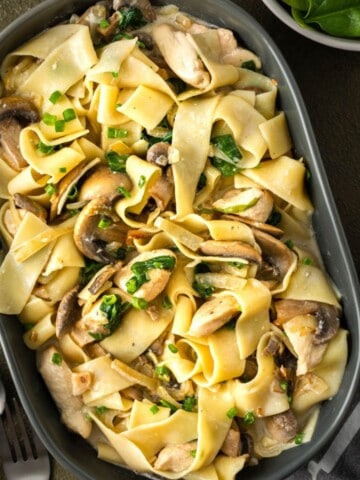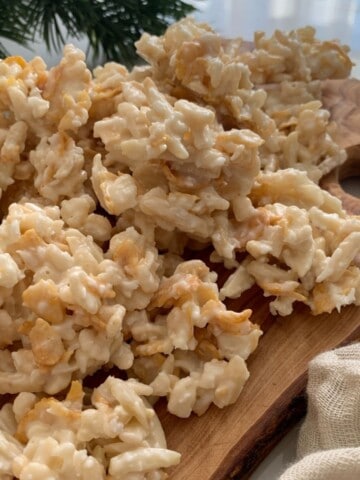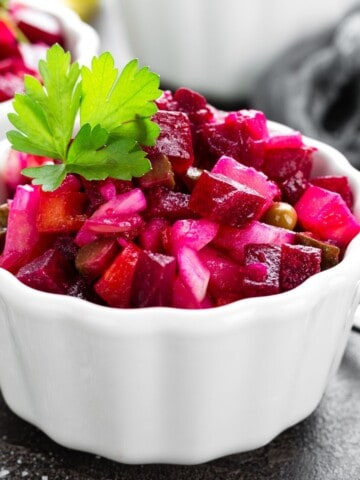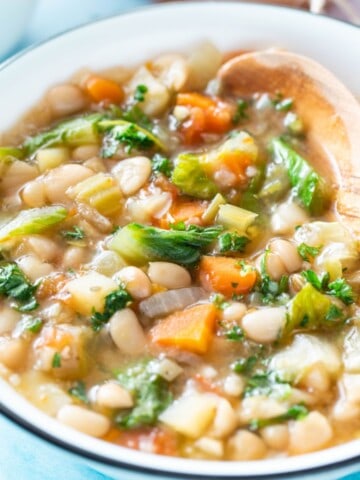Sprinkle a taste of Italy with Italian seasoning substitute blend, turning ordinary dishes into delicious Mediterranean masterpieces!

Italian seasonings are my culinary secret weapon! They are like a taste of Italy in every dish.
The aromatic blend of basil, oregano, and thyme takes me back to the cozy trattorias of Rome. It's my secret ingredient that transforms ordinary meals into delightful culinary journeys, filling my kitchen with the comforting scents of the Mediterranean.
Whether I'm making a hearty pasta sauce, tossing a fresh salad, or simply seasoning some roasted vegetables, Italian herb mix are a must-have in my culinary arsenal.
It's a reminder that simple herbs can weave a tapestry of flavors, creating dishes that warm the heart and satisfy the soul.
This recipe was inspired by my OVEN ROASTED POTATOES WITH ITALIAN HERBS and CREAMY CHICKEN AND MUSHROOMS PAPPARDELLE recipe.

Jump to:
- Why you'll love this recipe?
- The Main ingredients in Italian Seasoning
- How to make Italian seasoning substitute blend
- The best substitutes for Italian Seasoning
- Variations of Italian Seasoning mix
- Equipment
- MY FAVORITE KITCHEN TOOLS
- How to store homemade Italian Seasoning
- Recipes using Italian Seasoning
- FAQ
- Pairing these dishes with Italian Seasoning
Why you'll love this recipe?
I can certainly highlight some reasons why people might love an Italian seasoning substitute recipe:
Versatility: Italian spice blend is incredibly versatile and can be used in a wide variety of dishes. Whether you're making pasta sauces, pizza, roasted vegetables, grilled meats, soups, or salads, the Italian seasoning blend can enhance the flavors of these dishes with its aromatic herbs.
Convenience: Having a homemade Italian seasoning blend or store-bought one on hand saves time and effort. Instead of measuring and adding individual herbs each time you cook, you can simply reach for the Italian seasoning to add the desired flavors instantly.
Flavorful: The combination of basil, oregano, rosemary, thyme, marjoram, parsley and sage creates a well-rounded flavor profile that is both robust and balanced.
Customizable: Making your own Italian spice medley allows you to customize the proportions of each herb according to your taste preferences.
Authentic Italian Flavors: Using Italian culinary herbs helps you achieve authentic Italian flavors in your cooking.
Health Benefits: Many of the herbs in Italian herb assortment, such as basil, parsley, oregano, and thyme, offer various health benefits. They contain antioxidants and other essential nutrients that can support overall well-being.
Cost-Effective: Making your own Italian spice blend can be more cost-effective in the long run compared to buying pre-made blends. You can buy the individual dried herbs in bulk and create multiple batches of the seasoning.
Storage: Italian seasoning can be stored in an airtight container for an extended period, allowing you to have it readily available whenever you want to elevate the taste of your dishes.

The Main ingredients in Italian Seasoning
Italian seasoning substitute is a blend of herbs and spices commonly used in Italian cuisine to add flavor to various dishes. Traditional Italian seasoning typically includes a combination of the following dried herbs:
- Basil: Adds a sweet and slightly peppery flavor.
- Oregano: Brings a robust and earthy taste to the mix.
- Rosemary: Offers a pine-like aroma and a hint of citrus.
- Thyme: Adds a subtle, savory flavor.
- Marjoram: Has a milder taste, similar to oregano but slightly sweeter.
- Sage: Contributes a slightly peppery and herbal note.
- Parsley: Adds a fresh, slightly peppery taste and bright green color.
In addition to the primary herbs some variations of Italian spice blend may also include additional herbs and spices to enhance the flavor profile. These can include:
- Garlic powder: Provides a savory, garlicky essence to the mix.
- Onion powder: Contributes a subtle onion flavor.
- Red pepper flakes: Infuses a gentle heat and spiciness.
- Fennel seeds: Offers a mild licorice-like taste, often used in Italian sausages.
If you prefer to make your own Italian seasoning substitute blend, you can adjust the quantities of each herb according to your taste preferences. It's a great way to have control over the flavors and tailor them to your specific dishes. The dried herbs can be easily found in grocery stores, or you can dry fresh herbs yourself and create your custom blend at home.
See recipe card for quantities.

How to make Italian seasoning substitute blend
Making Italian seasonings at home is a simple process that allows you to customize the blend to your taste preferences. Here's a basic recipe for homemade Italian seasonings:
Step 1: Mix oregano, basil, thyme, marjoram, rosemary, sage, and parsley in a small bowl.
Step 2: After mixing, transfer the blend to an airtight jar. Seal and store it in a dark, room-temperature location, like your spice rack.
The best substitutes for Italian Seasoning
If you don't have all ingredients for Italian seasoning on hand or prefer to make your own blend, you can easily substitute it with individual herbs and spices commonly found in Italian cuisine.
Here are some substitutions for Italian seasoning mix:
- Substitution for Basil: Use fresh or dried basil to impart a sweet and slightly peppery flavor. If you don't have basil, you can also try using fresh parsley for a milder, herbaceous taste.
- Substitution for Oregano: Replace oregano with a mix of dried marjoram and thyme. Marjoram has a similar flavor to oregano, and when combined with thyme, it can mimic the earthy and slightly bitter notes of oregano.
- Substitution for Rosemary: If you don't have rosemary, try using a small amount of dried sage or thyme. Both herbs can add depth to your dish, though the flavor won't be exactly the same as rosemary.
- Substitution for Thyme: If you run out of thyme, you can use dried oregano or marjoram as substitutes.
- Substitution for Marjoram: If marjoram is not available, simply increase the amount of oregano in your blend or use a mix of oregano and basil.
- Substitution for Sage: For sage substitution, try using a small amount of rosemary or a pinch of dried thyme.
Remember that these substitutions may alter the overall flavor slightly, but they can still work well in various Italian dishes. Adjust the quantities according to your taste preferences and the specific recipe you are preparing. Making your own custom blend of herbs allows you to tailor the seasoning to your liking and the specific flavors you want to achieve in your cooking.

Variations of Italian Seasoning mix
Italian seasoning is a versatile blend, and there are various ways to customize it to suit your taste preferences or to add unique flavors to your dishes. Here are some variations for Italian seasoning:
- Garlic Italian Seasoning: Add garlic powder or granulated garlic to the basic Italian seasoning recipe for a more pronounced garlic flavor.
- Lemon Italian Seasoning: Incorporate dried lemon zest or lemon pepper into the blend to add a zesty citrus kick. This variation works well in seafood dishes, salads, and chicken recipes.
- Spicy Italian Seasoning: If you like some heat, add crushed red pepper flakes or a pinch of cayenne pepper to your Italian seasoning.
- Fennel Italian Seasoning: Include crushed fennel seeds to impart a hint of licorice-like flavor.
- Parmesan Italian Seasoning: Mix grated or powdered Parmesan cheese with the herbs for a cheesy twist on the classic blend. This variation works well as a topping for garlic bread or sprinkled over pasta dishes.
- Tuscan Italian Seasoning: Incorporate sun-dried tomatoes and dried bell peppers into the blend for a Tuscan-inspired twist. This variation works well in pasta dishes, salads, and bread.
- Herbs de Provence: Create a fusion by combining Italian seasoning with French-inspired Herbs de Provence, which typically includes herbs like lavender, savory, and tarragon.
Remember that these variations are just suggestions, and you can get creative by experimenting with different herbs and spices to make a custom Italian seasoning substitute blend that perfectly complements your favorite dishes. As you make changes, taste along the way to ensure the flavors align with your preferences. Enjoy the culinary adventure!
Equipment
To make Italian seasoning substitute blend, you'll need the following equipment:
- Measuring Spoons: To accurately measure the right amounts of herbs and spices.
- Mixing Bowl: A small bowl to combine the ingredients.
- Airtight Jars: For storing the Italian seasoning after mixing.
- Funnel (optional): To easily transfer the seasoning into the airtight jar without spills.
- Labels: To mark the jar with the name and date of the Italian seasoning.
These basic kitchen tools will help you prepare and store your homemade Italian seasoning efficiently.
MY FAVORITE KITCHEN TOOLS
The equipment section may contain affiliate links to products we know and love.
 Buy Now →
Buy Now →  Buy Now →
Buy Now →  Buy Now →
Buy Now → How to store homemade Italian Seasoning
Proper storage is essential to preserve the flavor and aroma of your homemade Italian seasoning or any store-bought blend. Here are some guidelines on how to store Italian seasoning effectively:
- Airtight Container: Transfer the Italian seasoning to an airtight container. This could be a glass jar with a tight-fitting lid or a resealable plastic or metal container. Ensure there is minimal air inside the container to prevent the herbs from losing their potency.
- Cool, Dark Place: Store the container in a cool, dark place such as a kitchen cabinet or pantry. Exposure to light, heat, and humidity can cause the herbs to deteriorate faster, leading to loss of flavor.
- Avoid Direct Sunlight: Keep the Italian seasoning away from direct sunlight as it can cause the herbs to fade and lose their essential oils, which contribute to their flavor.
- Dry Environment: Ensure that the storage area is dry. Moisture can lead to clumping and spoilage of the herbs.
- Avoid Near Heat Sources: Don't place the container near heat sources like stoves, ovens, or other appliances that generate heat.
- Avoid Refrigeration: Refrigeration is not necessary for dried herbs, and it may introduce unwanted moisture. Store Italian seasoning at room temperature for the best results.
- Labeling: If you have multiple herb blends or different seasonings, consider labeling the containers to easily identify them.
- Check for Freshness: Dried herbs do lose their potency over time, so it's a good idea to periodically check the seasoning for freshness. If the blend has lost its aroma and flavor, it's time to refresh it with a new batch.
By following these storage tips, your Italian seasoning should remain flavorful and ready to elevate your dishes for several months. Enjoy the convenience and versatility of having your own custom Italian seasoning blend on hand!

Recipes using Italian Seasoning
Italian seasoning can add delightful flavors to a wide range of dishes. Here's a list of recipes where you can use Italian seasoning:
Pasta Sauce: Use Italian seasoning in your favorite pasta sauce recipe for a burst of authentic Italian flavors.
Pizza: Sprinkle Italian seasoning over your homemade pizza, whether it's a Margherita pizza, a meat lover's pizza, or a veggie-packed one.
Garlic Bread: Mix Italian seasoning with softened butter, spread it on sliced bread, and toast it in the oven for delicious homemade garlic bread.
Roasted Vegetables: Toss your favorite vegetables (e.g., zucchini, bell peppers, cherry tomatoes, onions) with olive oil and Italian seasoning, then roast them until tender and flavorful.
Grilled Chicken: Marinate chicken breasts or thighs with olive oil, lemon juice, garlic, and Italian seasoning, then grill them for a savory and herb-infused dish.
Italian Dressing: Make your own Italian salad dressing by combining olive oil, red wine vinegar, Dijon mustard, honey, garlic, and Italian seasoning. Shake well and drizzle over salads.
Stuffed Bell Peppers: Mix Italian seasoning with ground meat (beef, turkey, or sausage) and rice, stuff it into bell peppers, top with tomato sauce and cheese, and bake until the peppers are tender.
Tomato Basil Soup: Add Italian seasoning to a comforting tomato basil soup to elevate the flavors and create a hearty Italian-inspired soup.
Baked Pasta Dishes: Whether you're making baked ziti, lasagna, or a cheesy pasta casserole, sprinkle Italian seasoning between the layers for an extra punch of taste.
Italian Meatballs: Use Italian seasoning in your meatball mixture along with breadcrumbs, grated Parmesan, and garlic for juicy and flavorful Italian-style meatballs.
Herb Butter: Blend softened butter with Italian seasoning, minced garlic, and a pinch of salt to create a savory herb butter that can be used on steaks, grilled vegetables, or baked potatoes.
Mediterranean Quinoa Salad: Toss cooked quinoa with chopped cucumber, cherry tomatoes, black olives, feta cheese, lemon juice, olive oil, and a generous sprinkle of Italian seasoning for a refreshing and light salad.
These are just a few ideas to get you started, but the possibilities are endless!
FAQ
Italian seasoning is typically made of a blend of dried herbs, including basil, oregano, rosemary, thyme, marjoram, and sage. The specific ingredients can vary slightly depending on the brand or recipe.
No, Italian seasoning and Herbs de Provence are different herb blends. While both blends contain some similar herbs like thyme and rosemary, Herbs de Provence typically includes additional herbs like lavender and savory, giving it a distinct flavor profile.
Properly stored in an airtight container in a cool, dark place, Italian seasoning can retain its flavor for several months. However, over time, the potency of the herbs may gradually diminish.
Yes, Italian seasoning's herb blend can enhance the flavors of various dishes beyond Italian cuisine. It can be used in Mediterranean-inspired dishes, roasted vegetables, grilled meats, dressings, soups, and more.
Pure Italian seasoning made from dried herbs is typically gluten-free and vegan. However, it's always a good idea to check the labels of store-bought blends to ensure there are no added ingredients that might contain gluten or animal products.
Traditional Italian seasoning does not contain salt. It's primarily a blend of dried herbs without added salt. However, some store-bought blends may include salt, so it's essential to read the label if you're concerned about sodium content.
While the traditional Italian seasoning blend is made with dried herbs, you can use fresh herbs if desired. Keep in mind that the flavor and potency may differ slightly, so you may need to adjust the quantities accordingly.
Pairing these dishes with Italian Seasoning
Looking for other recipes like this? Try these:

Italian Seasoning Substitute
- Total Time: 5 minutes
- Yield: 30 1-teaspoon servings 1x
Description
Sprinkle a taste of Italy with Italian seasonings, turning ordinary dishes into delicious Mediterranean masterpieces!
Ingredients
2 tablespoons dried basil
2 tablespoons dried oregano
2 tablespoons dried thyme
2 tablespoons dried rosemary
1 tablespoon dried marjoram
1 tablespoon dried sage
1 tablespoon dried parsley
Instructions
- Gather all the dried herbs required for the Italian seasoning blend.
- If using whole herbs, crush them with a mortar and pestle or pulse briefly in a spice grinder for a consistent texture (skip this step for pre-ground herbs).
- Combine all the dried herbs (and optional crushed red pepper flakes, if using) in a mixing bowl.
- Thoroughly mix the herbs to ensure even distribution.
- Taste a small amount of the Italian seasoning to check the flavor and adjust specific herbs' quantities if desired. Remember, the provided proportions are a guideline and can be customized to your preference.
- Once satisfied with the taste, transfer the Italian seasoning to an airtight container for storage.
- Store the Italian seasoning in a cool, dark place, away from direct sunlight, to retain its flavor for several months.
Notes
Remember my recipe is just a suggestion, and you can get creative by experimenting with different herbs and spices to make a custom Italian seasoning blend that perfectly complements your favorite dishes. As you make changes, taste along the way to ensure the flavors align with your preferences. Enjoy the culinary adventure!
- Prep Time: 5
- Category: Main Course
- Cuisine: Italian










Alexa's Cuisine
This is a great spice blend to always have on hand and very affordable!